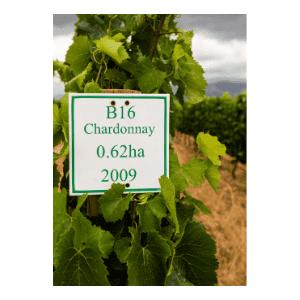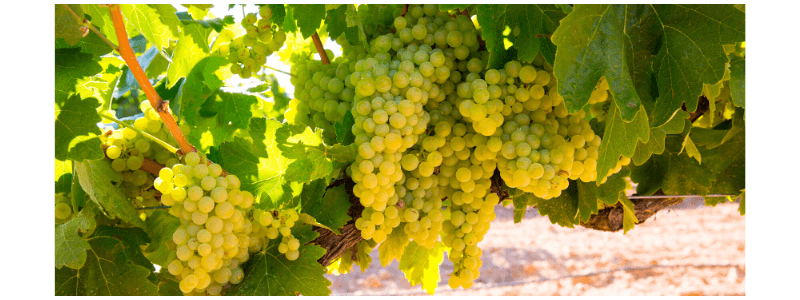No products in the basket.

I’ll show my hand upfront – I love a good Chardonnay but I know it is quite a divisive grape with many who don’t like it. Remember the “Anything but Chardonnay” or “ABC” era in the late 1990s? This was almost certainly a backlash against “Nothing But Chardonnay” being served. Chardonnay seemed to be just about everywhere and then sank almost into oblivion as Sauvignon Blanc became the white wine or grape “du jour”, superseded more recently by Pinot Grigio. Although it has always had a loyal band of followers Chardonnay wine is gaining new fans as people realise that there are different styles of Chardonnay. This guide to Chardonnay therefore looks at what wines are made from Chardonnay grapes, why Chardonnay can produce different wines, how Chardonnay wines taste and what to eat with different styles of Chardonnay.
Chardonnay is the most grown white wine grape in the world (a common pub quiz trick question, this used to be Spanish grape, Airén, but Chardonnay has now pushed that little known, mainly sherry-destined grape into second place). It is not surprising that it is so ubiquitous as it is very adaptable; Chardonnay performs well in hot, sunny climes as well as in cool climate areas. And it can express very well the terroir of different vineyards, which partly explains why the taste of Chardonnay can vary so much. Read more in my blogpost about terroir.
It is widely considered that the better-rated Chardonnay wines come from cool climate areas where the grapes will maintain their acidity. In hotter regions as the sugar rises in ripening grapes, the acidity falls away so Chardonnay wines produced in some of the hotter, often New World, regions risked being overly fruity and a little heavy. As the grape grows so easily there is also a temptation to produce high yields but high yields tends to mean lower quality, more dilute wine although this is a strongly-debated topic within the wine world. Perhaps a topic for a later blogpost!

And then there’s the oak issue: in the 1980s and 90s many winemakers tried to copy Burgundian methods since white Burgundy was definitely considered the epitome of Chardonnay and was highly acclaimed for its elegance, intensity and relative longevity. However many less reputable winemakers tried to copy Burgundian methods but in a much more commercial style which often produced wines which were over-oaked with very buttery flavours and little or no evidence of the grapes’ subtle fruit flavours or of the terroir.
This is not to say that any Chardonnay other than white Burgundy is poor quality. In fact, these days terroir is much more of a focus for better wine producers even in warmer climate regions. They recognise that terroir gives them the opportunity to show what makes their vineyards special. Over-oaking remains only at the lower end of the market.
Chardonnay’s versatility means that there are many different styles so it’s a case of finding your preferred style. Below are some of the different Chardonnay wines in stock with a brief hint of their styles.
For simplicity, I’ve narrowed the different styles of Chardonnay down to four main categories:.
Produced in cool climate Burgundy Chablis like the one on the left is perhaps the best known and best quality unoaked Chardonnay (though increasingly, more and more Chablis wines are oaked though more for the texture than for the taste).
Chardonnay with no oak influence tends to be leaner, crisper and dry, lighter in colour and in body, with flavours tending towards green apple, lemon, white flowers and flint or steel (think wet stones). Having no oak influence these wines can be very good examples of terroir-focused wines. Fermentation takes place in stainless steel to keep the wine cool and to preserve the acidity and the fruit flavours.
New World unoaked Chardonnays from cool climate areas in places like Australia, New Zealand, Patagonia and Oregon tend to display a little more fruit – melon, quince, apple, pear and grapefruit – but remain lighter and crisp in style.
Unoaked Chardonnay will pair well with fish dishes and seafood including oysters.
Chardonnay has an affinity with oak; the wines that have been fermented and aged in oak or just aged in oak are more full-bodied, creamy and will age further in bottle, the better wines for up to 10 years. Aside from traditional Burgundy white wines like Domaine Bachey Legros Bourgogne Saint Martin, you can find prime oaked Chardonnay in Australia, New Zealand, South Africa and Canada.
Aromas and flavours are usually more intense and more complex ranging from baked apples, coconut, brioche and bread, nutty flavours like hazelnut, spice like cloves and cinnamon, vanilla, caramel and cream. These wines are still dry but the oak also makes them richer, sometimes with an oily or buttery texture.
The oak does not need to be overdone and indeed the current trend, in order to produce more elegant wines with more subtle flavours, is to age wines in used barrels rather than in new barrels and to use barrels made from smaller-grained French oak rather than American oak.
Oaked Chardonnay can pair really well with richer foods like foie gras, lobster and scallops, smoked fish, creamy dishes like risottos and steak béarnaise, chicken, mushrooms, truffles, butternut squash and pumpkin Serve the wines a little warmer than you would serve crisper styles to release more aromas and flavours.
Early New World Chardonnays tended to be big wines with more tropical fruit flavours and there are still fans of this style. These bigger, more intense Chardonnays tend to originate in warm climate regions in California, South Australia, South Africa plus some parts of Southern Italy and Spain. As a very general rule, they will not be expensive.
The added sunshine, fermentation in stainless steel and maceration of the grapes on their skins help create those lush exotic fruit flavours such as pineapple, mango, ripe yellow apples and ripe peach. There may also be butterscotch and vanilla flavours if the wine is oaked.
This style will cope with richer, creamy dishes even mild curries but be careful of the fruity flavours overpowering the food .
Within the fruity category, there is a growing trend towards fruity Chardonnays with less intense, more subtle fruit flavours like green apples, pears with citrus fruit notes like Chacra Mainqué Chardonnay mentioned above and the Burgundian Domaine Sève Pouilly Fuissé Terroir.
These wines often don’t go through malolactic fermentation in order to preserve the fruity character of the wine. As the flavours in these wines are more delicate, strong-flavoured foods are best avoided and in fact these wines can often be better enjoyed as contemplation wines, without food.
There is a fourth style that we should not ignore and that is sparkling rather than still Chardonnay: “Blanc de Blancs” champagne or sparkling wine (white wine from white grapes). Whilst being fairly light and elegant in style, Blanc de Blancs also show complexity and concentration of flavours – citrus, apple, hazelnut, vanilla with mineral and floral notes. The best will have their acidity preserved through early grape picking so the wines are crisp. And with age they develop in creaminess and nut flavours.
Excellent on its own as an aperitif but will match a range of foods especially fish including caviar and sushi.
So if you think you don’t like Chardonnay give it another chance – quality is improving generally and today’s more elegant, fresher Chardonnays, whether oaked or not, are worth investigating. Find your style and give Chardonnay another chance!
© 2014-2025 Wines with Attitude Ltd | VAT Reg. No. 181 2419 22 | Registered in England 08918466 | Fiveways, 57-59 Hatfield Road, Potters Bar, Herts, EN6 1HS